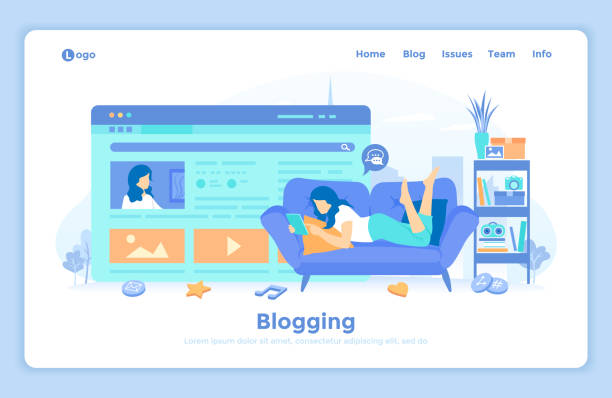An Introduction to Responsive Web Design and its Importance in the Digital Age

In today’s fast-paced world, where internet access is possible through various devices such as mobile phones, tablets, laptops, and even smartwatches, the importance of #responsive_web_design is more evident than ever.
Responsive Web Design is an approach that ensures your website provides the best display and performance regardless of the user’s device screen size.
This means automatically adjusting layout, images, and fonts to deliver a seamless and optimized User Experience.
In the past, many businesses had to design separate versions of their websites for mobile, which was a costly and complex process.
However, with the advent of responsive design, this problem has largely been resolved.
This approach not only improves your site’s SEO but also significantly increases user satisfaction.
Imagine how a user would feel when they visit a website on their mobile phone and constantly have to zoom in or scroll horizontally to see the content? It would certainly be an unpleasant experience leading to quick site abandonment.
Therefore, from an educational and explanatory perspective, it can be said that designing an adaptive website is now considered a golden standard in modern web design and plays a vital role in the online success of any business.
Does your company’s website perform as befits your brand? In today’s competitive world, your website is your most important online tool. Rasaweb, specializing in professional corporate website design, helps you to:
✅ Attract customer credibility and trust
✅ Convert website visitors into customers
⚡ Get a free consultation!
Why Responsive Web Design is No Longer a Choice, but a Necessity?

This is a crucial question: why has responsive website design become an absolute requirement rather than a luxury option? The answer lies in changing user habits and search engine approaches.
Global statistics show that a significant portion of web traffic, over 50%, comes from mobile devices, and this trend continues to grow.
Ignoring this vast volume of users means losing countless business opportunities.
From an analytical and news perspective, Google has explicitly stated that it prioritizes mobile-first indexing; meaning your site’s mobile version is the primary criterion for ranking in search results.
A website that is not well-optimized for mobile not only provides a poor user experience but also suffers a decline in Google rankings.
This means that if your site is not responsive, you are effectively falling behind in digital competition.
An adaptive website allows businesses to access all users across different platforms with a single investment, which in turn optimizes cost and time.
Furthermore, the bounce rate on non-responsive sites is significantly higher, as users quickly exit a site that does not display correctly.
In contrast, a website with responsive web design has a higher conversion rate and increases customer loyalty.
Therefore, it can be said that responsive website design is not only essential for survival in the digital market but also a powerful tool for growth and development.
This is a strategic investment for your online presence’s future.
Key Principles of Adaptive Website Design for Optimal Display

Implementing responsive web design is based on specific foundations, understanding which is essential for every developer and business owner.
These principles, which are specialized and educational in nature, ensure your website looks flawless on any device.
The three main pillars of responsive design are: Fluid Grids, Flexible Images, and Media Queries.
Fluid grids use relative units like percentages instead of fixed pixels, allowing page layouts to adapt to screen sizes.
This means that the width of columns or content blocks, instead of having a fixed size, occupy a percentage of the total page width and automatically resize as the page shrinks or expands.
Flexible images work similarly; using CSS, one can ensure that images automatically resize and do not exceed their container’s capacity, which prevents layout disarray.
Media queries are the heart of responsive web design.
These tools allow developers to apply different CSS rules based on device characteristics such as screen width, height, orientation (landscape or portrait), and media type (screen or print).
For example, one can specify that on small screens, the navigation menu is displayed as a hamburger icon, while on large screens, it appears as a full menu bar.
These principles work together to create a truly adaptive and optimized website.
In the table below, we compare different website design approaches:
| Feature | Fixed Design | Fluid Design | Responsive Design |
|---|---|---|---|
| Units of Measurement | Fixed Pixels (px) | Percentage (%), em | Percentage (%), em, rem, vw/vh + Media Queries |
| Device Compatibility | Poor, requires horizontal scrolling | Medium, content may become unreadable | Excellent, optimal display at any size |
| Maintenance | Simpler, but requires separate mobile versions | Medium | Medium, single codebase management |
| SEO | Weaker (requires redirects, duplicate content) | Medium | Excellent (single URL, high user experience) |
Unparalleled User Experience with Responsive Website Design

The main goal of any website is to deliver content and services to users in the most effective way possible.
In this regard, responsive web design plays an unparalleled role in creating an exceptional user experience (UX).
An adaptive website creates a sense of satisfaction and ease for the user, regardless of the device they use for browsing.
Imagine an e-commerce website that looks beautiful and functional on your laptop, but on mobile, its images are jumbled, buttons are tiny, and navigation is difficult.
Such an experience immediately leads to user frustration and exit.
In contrast, a website with responsive design ensures smooth navigation, touch-friendly buttons, and logical content arrangement at any size.
This practical guidance easily leads the user to their goal, whether it’s purchasing a product, reading an article, or filling out a form.
Improving user experience means reducing bounce rate, increasing time spent on the site, and ultimately, increasing conversion rates.
Users stay longer on a site that cares about them and provides an enjoyable experience, turning into loyal customers.
From an entertaining perspective, one can also look at how an adaptive website, like a constant companion, is always ready to provide the best service.
This feeling of comfort and accessibility is beneficial not only for users but also for your brand, creating a positive image of your business in the audience’s mind.
Therefore, responsive web design is not just a technical tool, but a powerful strategy for attracting and retaining customers.
Did you know that a poor corporate website costs you many opportunities daily? Solve this problem forever with professional corporate website design by Rasaweb!
✅ Create a powerful and reliable image for your brand
✅ Targeted attraction of new customers and increased sales
⚡ [Get a free website design consultation]
SEO Benefits of Responsive Site Design from Search Engine Perspective

One of the most important reasons responsive web design has become an industry standard is its countless benefits for SEO (Search Engine Optimization).
This analytical and specialized aspect is vital for anyone looking to improve their online visibility.
Google, as the world’s largest search engine, has officially endorsed responsive design as the recommended approach for creating mobile-friendly websites.
The reason is simple: a responsive website has only one URL per page, which significantly simplifies crawling and indexing for Google’s robots.
In contrast, websites with separate mobile versions (e.g., m.example.com) can face challenges with duplicate content and complexities related to link management, which may harm their SEO ranking.
Another SEO benefit of responsive web design is the reduced bounce rate.
As mentioned earlier, an improved user experience encourages users to stay on your site longer and view more pages.
These positive signals are sent to Google, indicating that your content is valuable and relevant, which can help improve your ranking.
Furthermore, sharing content via social networks is easier with a single URL, which itself leads to increased social signals and ultimately improved SEO.
Finally, given Google’s mobile-first approach, having a website with responsive web design not only helps you avoid penalties but also gives you a significant competitive advantage in search results.
This investment in technology will yield substantial returns in visibility and audience attraction.
Advanced Tools and Techniques in Responsive Website Design

For effective implementation of responsive web design, developers require a set of advanced tools and techniques that demand a specialized and educational approach.
One of the most popular tools is the use of CSS frameworks like Bootstrap and Foundation.
These frameworks significantly accelerate the design and development process by providing a predefined grid system and responsive UI components.
They enable the creation of web pages with complex layouts that automatically adapt to various screen sizes.
In addition to frameworks, the use of CSS preprocessors such as Sass and Less is also very common.
These tools allow writing CSS with programming capabilities like variables, functions, and inheritance, making coding more organized, maintainable, and efficient.
This is particularly useful in large responsive website design projects that require managing a large volume of CSS code.
Another critical technique in responsive web design is the correct use of the viewport meta tag.
This HTML tag, placed in the <head> section of the page, tells the browser how to manage the page’s dimensions and scale for proper display on different devices.
Without this tag, mobile browsers might display the page in desktop mode and then shrink it.
Furthermore, modern CSS techniques like Flexbox and CSS Grid Layout are powerful tools for creating complex and responsive layouts, offering much more flexibility than traditional methods based on floats or tables.
Learning and mastering these tools and techniques is essential for anyone seeking to implement a professional and optimized responsive web design.
Common Challenges in Responsive Design and Practical Solutions

Although responsive web design offers many advantages, its implementation is not without challenges.
Understanding these challenges and knowing their practical solutions is crucial for any developer and business looking to successfully implement this approach.
This explanatory and guiding section addresses some of the most common problems and their solutions.
One of the biggest challenges is performance.
Responsive websites can slow down if not properly optimized, especially on mobile devices with poor internet connections.
This slowness is usually due to loading high-resolution images for all devices or excessive use of CSS and JavaScript code.
Solutions to this problem include optimizing images (such as using responsive images with the <picture> tag or srcset attribute, compression, and lazy loading), code minification, and using Content Delivery Networks (CDNs).
Another challenge is the complexity of testing and debugging.
With countless devices and screen sizes, ensuring the website displays correctly on all of them is difficult.
To overcome this challenge, using browser simulator tools, testing on real devices, and leveraging automated testing frameworks are recommended.
Maintaining and updating the codebase can also be challenging, as changes in one section might affect other sections at different screen sizes.
Using an organized code structure, CSS variables, and development frameworks can help simplify this process.
Responsive web design requires careful attention to detail and anticipating user behavior in various scenarios.
Understanding these challenges and applying appropriate solutions is the key to success in this field.
The table below provides an overview of common challenges and their solutions:
| Challenge | Description | Practical Solution |
|---|---|---|
| Slow Performance | Slow site loading due to large images or unoptimized code | Image optimization (responsive images, compression, lazy loading), Minification, CDN |
| Testing Complexity | Ensuring correct display on thousands of different devices | Testing on real devices, using browser development tools, testing frameworks |
| Content Management | Delivering appropriate content at different sizes (more or less) | Using Content Management Systems (CMS) with responsive capabilities, conditional content with Media Queries |
| Navigation and UI | Designing menus and buttons for touch experience and different sizes | Mobile navigation patterns (hamburger menu), large and touchable buttons, appropriate typography |
The Future of Responsive Web Design and New Horizons in the Digital World

The world of web is constantly evolving, and responsive web design is no exception.
The future of this field is full of new and exciting horizons that demand an analytical and news-driven approach.
One of the most important trends is the increasing growth of Progressive Web Apps (PWAs).
PWAs combine the best features of web and mobile applications, offering a native app-like experience through a web browser.
These applications can work offline, send push notifications, and even be installed on the device’s home screen, which is a big step in improving user experience.
PWAs, with their built-in responsiveness, are shaping the future of adaptive websites.
Artificial intelligence (AI) and machine learning will also play an increasing role in web design.
AI-powered tools can automatically optimize layouts, personalize content, and even analyze user behavior patterns to provide a responsive and customized experience.
Responsive web design in the future may go beyond traditional screens to include Voice User Interfaces (Voice UI) and Augmented Reality (AR).
With the increase in Internet of Things (IoT) devices and various displays, the need for websites that can adapt to any environment is felt more than ever.
These developments show that responsive web design is not just a fixed concept but an evolving philosophy that keeps pace with technological advancements.
Ultimately, the goal is always to create easy access and a flawless experience for users, regardless of their platform and device.
Are you losing customers because of your e-commerce site’s outdated look or slow speed? Rasaweb’s expert team solves these problems with professional e-commerce website design!
✅ Increase customer trust and your brand’s credibility
✅ Stunning speed and excellent user experience
Get a free consultation with Rasaweb right now ⚡
Step-by-Step Guide for Implementing Responsive Website Design

-
Planning & Research:
First and foremost, you need to know your audience and understand which devices they use most.
Tools like Google Analytics can provide valuable insights in this area.
Additionally, examining competitors and best practices in your industry is also beneficial. -
Mobile-First Approach:
Start designing from the smallest screens.
This approach ensures that the most important content and functionalities are accessible to mobile users, and then gradually add features for larger screens.
This perspective ensures that your responsive web design is fundamentally solid and functional. -
UI/UX Design:
Design the site map and wireframes for different devices.
Pay special attention to navigation, button sizes, and text readability on small screens. -
Coding with Responsive Principles:
Use semantic HTML and CSS with relative units (percentages, em, rem, vw/vh).
Employ Media Queries to apply different styles at various breakpoints.
Make images flexible and use thesrcsetattribute for them. -
Performance Optimization:
Alongside development, consider optimizing loading speed.
Image compression, Minification of CSS and JavaScript codes, and using CDNs are essential actions. -
Testing & Debugging:
After completing the coding, test your website on various devices and browsers.
Use browser development tools (like Inspect Element in Chrome) and online responsiveness testing tools.
Continuously strive to find and fix issues. -
Launch & Monitor:
After ensuring proper functionality, launch the website.
Subsequently, use tools like Google Analytics and Google Search Console to monitor site performance on different devices and gather user feedback for future improvements.
These steps ensure that your responsive web design is not only beautiful but also fully functional and optimized.
The Ultimate Goal of Responsive Website Design: Creating an Accessible Web World

Ultimately, beyond techniques and tools, the ultimate goal of responsive web design is to create a world of web that is accessible to everyone, everywhere, and on any device.
This is a grand and exciting goal that not only satisfies users but also contributes to the sustainable growth of businesses.
When a website is built with responsive design, it effectively creates a bridge between content and users, irrespective of hardware or software limitations.
This means equal access to online information, services, and opportunities for all.
For businesses, this global accessibility translates to a potential increase in customers, improved audience engagement, and the creation of a positive brand image that cares about its customers.
An adaptive website is a long-term investment that proves its worth over time.
With constantly changing technology and the emergence of new devices, a responsive site does not require a complete redesign and can adapt to new needs.
This means reduced maintenance and update costs in the future.
Responsive web design is not just a technical solution but a design philosophy based on the principle that websites should be as flexible and adaptable as their users.
This approach means going beyond beautiful aesthetics and focusing on functionality and efficiency.
In today’s world, where digitalization has permeated our lives, responsive web design is not just an advantage but a social responsibility that ensures no one is deprived of access to online information and services.
This is the realization of the dream of a unified and global web.
Frequently Asked Questions
| Question | Answer |
|---|---|
| What is Responsive Web Design? | It is an approach that ensures your website’s layout displays well on any device (such as mobile, tablet, and desktop) and adapts to the user’s screen size. |
| Why is responsive design important? | Improved user experience across different devices, increased traffic and conversion rates, improved search engine rankings (SEO), and reduced need for developing separate mobile versions. |
| How is responsive design implemented? | By using CSS media queries to apply different styles based on device characteristics (like screen width), and by using flexible grids (Fluid Grids) and flexible images. |
| What are the main technologies used in responsive design? | HTML5, CSS3 (especially Media Queries), and JavaScript. |
| What are the main benefits of responsive design? | Consistent user experience across different devices, easier website maintenance, better SEO (as Google prefers responsive sites), and cost and time savings compared to developing separate mobile applications or sites. |
And other services of Rasaweb Advertising Agency in the field of advertising
Smart Marketing Automation: A fast and efficient solution for improving SEO ranking with a focus on marketing automation.
Smart Data Analysis: A combination of creativity and technology to attract customers through custom programming.
Smart Sales Automation: A fast and efficient solution for increasing click-through rates with a focus on marketing automation.
Smart Brand Identity: A professional solution for digital branding with a focus on optimizing key pages.
Smart UI/UX: An effective tool for digital branding with the help of real data.
And over a hundred other services in the field of internet advertising, advertising consultation, and organizational solutions
Internet Advertising | Advertising Strategy | Advertorial
? Rasaweb Afarin Digital Marketing Agency, your strategic partner on the path to online brilliance and sustainable business growth. Keep your brand at its peak with our professional services in SEO-optimized website design and digital marketing.
📍 Tehran, Mirdamad Street, next to Bank Markazi, Southern Kazeroon Alley, Ramin Alley, No. 6




